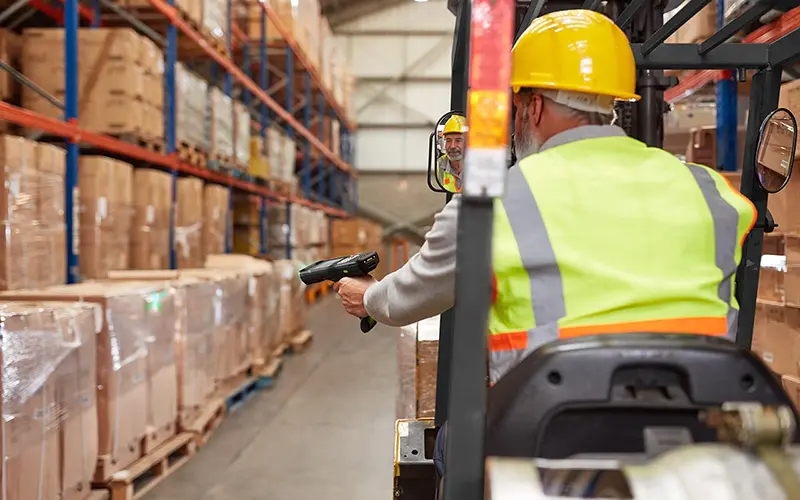
RFID (Radio Frequency Identification) has long been viewed as a game-changing technology for logistics, retail, healthcare, and manufacturing.
By adding RFID to their supply chain, organizations are gaining real-time visibility into the movement of inventory, assets, and equipment—without the need for manual scanning or line-of-sight. This means faster receiving, fewer stockouts, and more accurate inventory counts. RFID also helps automate key processes like order picking, cycle counting, and shipment verification, which reduces labor costs and eliminates human error.
Perhaps most importantly, RFID provides actionable data that helps businesses respond faster to disruptions, optimize warehouse layouts, and strengthen customer satisfaction.
But despite these well established benefits and growing adoption by major players like Walmart, FedEx, and Amazon, many businesses still hesitate to jump on board.
Why? Because outdated myths are holding them back.
Setting the Record Straight on RFID
RFID can seem tricky and confusing at first—between the tags, readers, frequencies, and acronyms, it’s easy to feel overwhelmed. But the truth is, RFID is more accessible and more powerful than ever.
Like any fast-evolving technology, RFID has carried some baggage over the years. Early systems were expensive, harder to implement, and less reliable around certain materials. Those challenges created a reputation that, while once deserved, no longer reflects reality.
So let’s set the record straight and break down the most common misconceptions, so you can feel confident about using RFID to improve your operations, boost efficiency, and future-proof your business.
Myth #1: RFID is Too Expensive
RFID used to be pricey. Today, it’s surprisingly affordable.
Passive RFID tags can cost as little as 5–10 cents each, and prices continue to drop. Why? Because RFID technology has scaled dramatically. With global retailers like Walmart, Decathlon, and Uniqlo adopting RFID at scale, demand has skyrocketed—driving production volumes up and prices down. At the same time, advances in chip design, antenna materials, and manufacturing automation have made tags cheaper and more reliable than ever.
And you don’t need to tag every single item to see value. Many companies start by tagging only high-value assets or cases and pallets—getting a strong return on investment with a targeted rollout.
Bonus: The ROI of RFID often speaks for itself. Most companies see payback in under 18 months thanks to labor savings, reduced shrinkage, and improved inventory accuracy.
Try our RFID ROI Calculator to see what kind of cost savings you can expect from adding the technology to your supply chain.
Myth #2: Barcodes Work Fine—Why Change?
Barcodes are useful—but limited.
Barcodes require line-of-sight and manual scanning, which means slower processes and higher error rates. RFID, on the other hand, can read dozens or even hundreds of tags at once—without needing direct visibility.
Our RFID technology is typically 10 to 20 times faster than traditional barcode scanning. Instead of manually scanning each item one by one, RFID readers capture data from dozens—or even hundreds—of tags at once, with no line of sight needed. That means faster processing, less labor, and way fewer bottlenecks.
Think of barcodes as walkie-talkies, and RFID as Wi-Fi. Both communicate, but one offers faster, broader, and more automated coverage.

Myth #3: RFID Is Too Complicated to Implement
For many years, the prevailing belief was that RFID was only beneficial to very large corporations. And to be fair, that used to be true—because only enterprise-level companies could afford to build custom software platforms capable of handling the volume and complexity of RFID data. But that’s no longer the case.
Modern RFID solutions are easier to roll out than ever.
Today, there are powerful out-of-the-box solutions that make RFID implementation accessible for businesses of all sizes. With plug-and-play readers, cloud-based software, and flexible middleware, you don’t need to be a Fortune 500 company to get started. Many vendors offer pilot programs, modular deployments, and integration support with existing systems like WMS, ERP, or POS.
You can start small—like tagging high-value assets or automating dock door scans—and scale up as you see results.
💡 Pro Tip: Our EdgeMicro platform makes it easier than ever to dip your toes into RFID. It’s designed for quick-start pilots, small rollouts, and proof-of-concept projects—so you can see the value fast, without a massive upfront investment.
Myth #4: Barcodes Work Fine—Why Change?
For many years, it was a fairly known fact that RFID and liquids did not work well together. This meant that using RFID to track things like high end liquor bottles, cosmetics, industrial equipment, and chemical liquids was not possible.
RFID technology has evolved—and works just fine around challenging materials.
While older RFID systems struggled with interference from metal or water, today’s specialty tags and tuned antennas are specifically designed for tough environments like manufacturing plants, healthcare facilities, and even freezers.
Brands such as Xerafy and HID specialize in creating RFID tags for all kinds of environments and tracking necessities. If you can label it, you can track it. You just need the right tag for the job.
Myth #5: RFID Slows Down Operations
For some manufacturers and warehousing professionals, RFID is seen as an annoying thing that retail vendors force upon them. These vendors hand down RFID compliance mandates to their partners, who are then compelled to properly encode RFID tags, which then get affixed to the merchandise they manufacture or distribute. And thus, RFID is quickly seen as a bother that just slows down an otherwise efficient operation. This could not be further from the truth.
RFID speeds things up—significantly.
From automated check-ins and real-time inventory counts to instant location tracking, RFID removes manual steps and reduces bottlenecks. In logistics environments, RFID has been shown to cut order processing times by up to 90%.
The result? Faster fulfillment, fewer errors, and happier customers.
And, for companies who are in the midst of an RFID mandate, using the RFID tags you’ve been mandate to add to inventory allows you to actually save money you’d otherwise lose on shipping errors and other operational mistakes.
Final Thoughts: Don’t Let Myths Cost You Money
RFID is no longer the “future” of logistics and inventory management—it’s the now. And the biggest companies in the world are already using it to boost speed, visibility, and efficiency.
If you’re still holding back because of outdated myths, you might be costing your business more than you think.
Interested in RFID?
An RFID tracking system can help organizations of all sizes improve their supply chain efficiency. Contact the CYBRA team to schedule a demo today.















